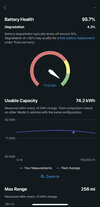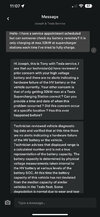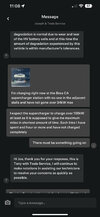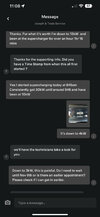Hello everyone,
I am a new Tesla owner as of ~ 2 weeks ago with a 2015 MS 85D. I have scoured these forums for hours reading about chargegate and batterygate etc... I hope to find some answers from those that have owned a 85D for longer than I have.
I have a service appointment with Tesla for the MCU2 upgrade next Saturday 11/5. They also just randomly added the eMMC recall replacement to my work order. I have tried using the supercharger a few times since purchase and found that the charge speed is ~30kW/hr the entire time when the battery is ~70% full till up to 90% then drops to a painful 3kW/hr or less.
I reached out to Tesla about this and similar to others, got the standard "remote diagnosis of your battery seems fine" reply (screenshots attached)
I still have around a year left on the battery warranty and I am trying to do as much diagnosis myself to understand if mine will last for years or if I need to try and request a replacement from Tesla. The Tessie app shows only 4.3% battery degradation (screenshot attached) but I don't know how much hope I can put into that figure.
I just started using TeslaFi but don't know what data points to look at or share with you guys to understand real health of the battery.
Appreciate any feedback from the community on this and if there is any other information needed please let me know.
I am a new Tesla owner as of ~ 2 weeks ago with a 2015 MS 85D. I have scoured these forums for hours reading about chargegate and batterygate etc... I hope to find some answers from those that have owned a 85D for longer than I have.
I have a service appointment with Tesla for the MCU2 upgrade next Saturday 11/5. They also just randomly added the eMMC recall replacement to my work order. I have tried using the supercharger a few times since purchase and found that the charge speed is ~30kW/hr the entire time when the battery is ~70% full till up to 90% then drops to a painful 3kW/hr or less.
I reached out to Tesla about this and similar to others, got the standard "remote diagnosis of your battery seems fine" reply (screenshots attached)
I still have around a year left on the battery warranty and I am trying to do as much diagnosis myself to understand if mine will last for years or if I need to try and request a replacement from Tesla. The Tessie app shows only 4.3% battery degradation (screenshot attached) but I don't know how much hope I can put into that figure.
I just started using TeslaFi but don't know what data points to look at or share with you guys to understand real health of the battery.
Appreciate any feedback from the community on this and if there is any other information needed please let me know.











